“Hyōgen no kōzō”
Chapter 6 from Manga wa naze omoshiroi no ka: sono hyōgen to bunpō (Why Is Manga So Interesting? Its Expression and Grammar, NHK Library, 1997), pp. 80-96.
This essay by Natsume Fusanosuke is a translation of the sixth chapter from a 1997 book titled after a 12-episode NHK television program Natsume hosted the year prior: Why Is Manga So Interesting? Its Expression and Grammar (Manga wa naze omoshiroi no ka: sono hyōgen to bunpō). Originally published in pamphlet form to accompany the show, this chapter (among others) highlights Natsume’s “manga expression theory” (manga hyōgen-ron). Departing from the previous generation of manga critics and scholars, Natsume helped pioneer a style of writing about manga in the 1990s based on three constituent elements: words, pictures and panels. For NHK’s television viewers (and, later, readers of the full book version), Natsume offered a reminder of how manga could be so interesting and pleasurable. Like others in the new wave of 1990s manga scholars (including Yomota Inuhiko, Ōtsuka Eiji, Takekuma Kentarō and others), Natsume downplays discussion theme or plot in favor of visual elements: “I feel that manga is interesting depending upon what kind of line is used, what kind of pictures are drawn, and in what ways the panels are laid out. We find it has ‘something interesting’ if the manga uses expressions that are manga-esque (manga ga manga-tarashimeru shikumi no naka de ‘omoshirosa’ o kanjite iru no da).”1
In this chapter, Natsume delves into how manga artists often make use of the “line” (sen) to depict the invisible as visible. There is a tacit assumption shared by manga artists and readers that often we get more visual information from the page than what we can observe in nature. Building on earlier portions of the book, where he discussed nonsense and gag manga artists Tanioka Yasuji and Sugiura Shigeru, here Natsume focuses on the “rules” and “conventions” of what manga artists can expect their readers to tacitly accept, often so that the former can add more enjoyment and entertainment for the latter. In addition, he explores the rich range of symbols available to Japanese artists, including those ubiquitous marks of sweat, steam, tears and more, used freely on the most realistically drawn character as much as the most cartoony one. There is no contradiction, no need to be compliant to one uniform drawing register, as in so many American comics. Japanese artists freely use their line to both depict and loosely symbolize the worlds and feelings of their comic characters. Interested readers are advised that the Tiger Tateishi comics Natsume discusses have just been collected in a first-ever western edition by Philadelphia's 50 Watts Books.
Finally, it is worth noting that Natsume, as a former manga artist, deploys his own drawings in his explanations. In this chapter, we see his typical cartoony style supplementing his written argument. The images of emoting light bulbs (Figures 3 to 7) proved so iconic they were used for the cover of the 2012 Chinese-language edition of Why Is Manga So Interesting? In all, Natsume crafts an important statement about the power and flexibility of the Japanese manga line. Alongside an earlier mixed-author essay collection How to Read Manga (Manga no yomikata; Takarajima, 1995), which Natsume co-edited in addition to his numerous writing contributions, Why Is Manga So Interesting? is an important early volume in Manga Studies from the period of the 1990s. The translators thank Natsume-sensei for his permission to translate this chapter/essay; we hope it will help expand awareness of manga in the field of Comics Studies.
-Jon Holt & Teppei Fukuda
* * *
Nonsense Manga that Overturn All the Rules of Manga
Let’s take a look at something before we really get started (Figure 1). It is a work called Cheat Sheets (Tora no maki,2 1982) by Taigā [Tiger] Tateishi, and it is a nonsense manga that has become quite rare these days in Japan. Cheat Sheets actually reads from left to right, like American and European comics do.

What we see here are two characters swinging a jump rope, but at some point the rope becomes a pea pod. Then, in another flash, from that pea pod jumps forth a human-like pea person. It has become almost impossible to see such a pure form of nonsense manga in Japan these days. The mainstream of manga now is in the form of long-running story comics. Personally, I wish we could see more short gag manga like Cheat Sheets. Some people might say, “Ok Natsume, then why don’t you draw them yourself?!” I hear you, but let me excuse myself - drawing this kind of stuff is really tough. Plus, it doesn’t sell either.
What we see in the beginning is a simple line (sen) that signifies the jump rope. Then, the line becomes more complicated, transforming into a bunch of lines that indicate motion, as the artist is showing the two people swinging it around repeatedly. The flexible shape looks a lot like a pea pod, and, from this similarity, the idea for this joke is born. The key to the joke is that Tiger draws a single line to illustrate the rope; and, to express the movement of it, he uses multiple lines. This idea is executed though a particular feature of lines: that they can have multiple roles and meanings, like we saw in the previous chapter.
First of all, the artist can only do this if we allow that one can take a rope, which is a real thing with a real thickness to it, and abstract it down to the level of just one line. However, if the rope remained as just one line, Tiger could not make it resemble a pea pod. That is exactly where he utilizes the act of drawing multiple lines, which express motion within the conventions of manga, into an image that makes those lines then resemble the pea pod. The idea comes from the fact that lines can indicate something in motion, in addition to a single line that alone can depict a thing.
The line starts out as a rope, then shows motion, and then becomes a pea pod. Such a transformation is only possible once an artist like Tiger decides to turn the tables on the very conventions that constitute manga cartooning.
Here is the point that differentiates Tiger Tateishi from Tanioka Yasuji and Sugiura Shigeru, whom I introduced in the previous chapter as two artists who illustrate the primitively polymorphous properties of lines.3 In Tiger’s case, he intentionally leverages the very rules of manga against itself, and then he produces this nonsense joke from the commonsense awareness that, normally, lines which can express so many things in manga, in actuality are just lines. That is why one often gets a very theoretical feeling from his works.

I have one more example from Tiger; it shows a mountain growing beyond the horizon line, and then getting cut off and carried away by that very line of the horizon (Figure 2). The artist creates the horizon with just one simple line, but then he gets the idea that even such a line could betray the silent conventions between manga and its readers. It is a kind of trompe l'œil that is split into panels. Normally, if a mountain were to grow into some high peak, then the horizon line would become lost behind the foreground, yet Tiger draws the horizon slicing the mountain in half. When he does that, the horizon is no longer just a horizon, and the reader will see the aspect of it being just an abstract line.
It is safe to say that such an artist is one that has a particular theoretical view of what lines and forms that are drawn with those lines are. Because he makes manga like this, he betrays the line’s relationship to its illustrated object or landscape. And by turning the convention upside down, he helps us become more aware of a basic convention in manga.
The convention I am talking about here is the unstated rule that when lines are used to embody shapes within such reciprocal relationships, those simple lines become a certain thing—be it a swinging jump rope or the horizon line—and you must stick with what you drew with those lines, and they must not go beyond what they have depicted.
Manga Expression: A Series of Rules and Conventions
By their very nature, line drawings embody these set conventions; for example, if you add two dots inside a circle, you get a face. It's just one of those tacit agreements to pictures. What I mean is that humans are imprinted with such understandings - in a bit of fishy way, though, as if it is a human instinct. Simplified pictures used to mark men’s or women’s bathrooms would be a good example of this kind of axiom. Because of this rule, when people see those images, they will know that one is a man, that the other is a woman. They also use codes like a necktie or a skirt for male or female, so we cannot say that this is something innately human; we should call this cultural coding.
In the previous chapter, I gave two examples of word balloons where one was sharply exploding and communicating a sense of urgency, and the other was round and communicating a sense of calm. We saw how those feelings strike us naturally through the way we, as humans, see the shapes of those lines. On the other hand, there is artifice in how the manga expressions of those balloons make us automatically think, “If there are words inside balloons like those, then they must be lines of dialogue uttered by some character.” Ultimately, most manga expressions are like that. There are many more and many different kinds of tacitly accepted rules that govern the expressions of manga.
The manga expression of “sweat” is a perfect example. In manga, a character’s sweat will start to trickle when he is surprised, when he feels a bit of pressure, or when he feels some kind of anxiety. If you think about it, in reality the chances of you seeing a live human being breaking into a sweat when he gets surprised are pretty rare, but it is just a form of hyperbole often used in manga. However, when a manga character starts to have a bead of sweat form on his cheek, we know that it means something like, “Ah, he’s starting to feel a little pressure.” These kinds of “sweat” are really just signs of “worry” or “panic,” and, over time, such “sweat” has come to function as a kind of modifier that works independently from the other pictures in the frame.
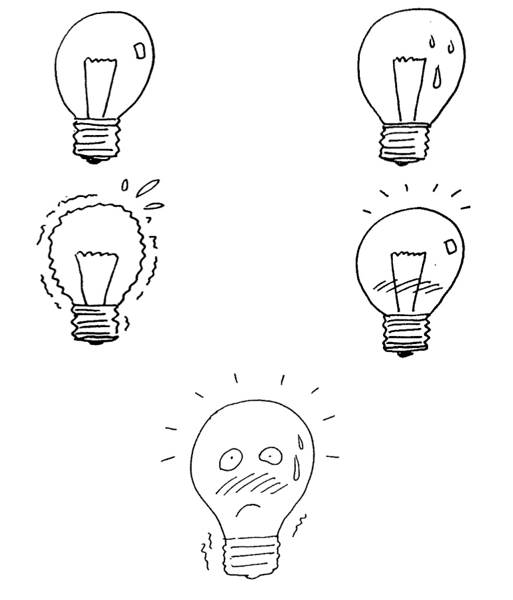
Let’s consider these signs with other examples, this time variations of a picture of a simple light bulb (Figure 3). Now, just by adding a couple of beads of sweat to it, we will suddenly start seeing our light bulb breaking into a panic or showing some kind of worry (Figure 4). Similarly, there are many other kinds of manga signs that one could use to depict other emotions. I can draw a fearful, trembling light bulb (Figure 5), a light bulb flushed with embarrassment (Figure 6), and so on.
To tell the truth, the sweat from Figure 4 can look like it is just wet; the fearful form [Figure 5] can look like it is just trembling in a slightly vibrating, slightly fluttering kind of motion; and the embarrassed [Figure 6] can look like it is just glittering. When I add on some eyes and a nose to our light bulb, it really takes on something resembling human emotion (Figure 7). These manga-like signs have their meanings determined by their reciprocal relationships with other elements in the pictures, much in the same way that words function within their parent sentence.
In Figure 4, if one sees those beads not as sweat but as water drops, then the image is primarily one where its line is showing something that actually could exist in reality. For other types of pictures, like Figures 5 and 6, where we see the light bulbs as wavering or bursting with light, then those images must be drawn in an abstract way to use their lines as a kind of code for lines that no one could really ever see. When such droplets, shaking or flashes seem to us like human psychology or emotional feelings, then it must be because such abstractions are another layer of abstraction on top of the expressions that have already become a part of the many coded conventions in manga.
The Keiyu “Shape Metaphor”: Abstractions Taken to the Next Level
Once we say that pictures, panels and even words can be a type of code, we can also then say everything in manga consists of code. In order to describe independently coded elements that often operate within any manga, often at secondary or tertiary levels of abstraction, I use the invented term keiyu [shape metaphors].4 I use this term because what’s happening is the artist is using the form of the line itself to allude to some other meaning. There are so many different types of keiyu. Besides the drops of sweat or flashes of light, there could be lines that indicate the movement of things; there could be bubbles floating around a person’s head when he is drunk; there could be messy clouds of smoke from a person being either confused or utterly disappointed; veins that pop out when a person is super-stimulated or very angry; band-aids that appear to show a person’s wound. In Figure 8, I try to show some examples, but that group is just the tip of the iceberg.
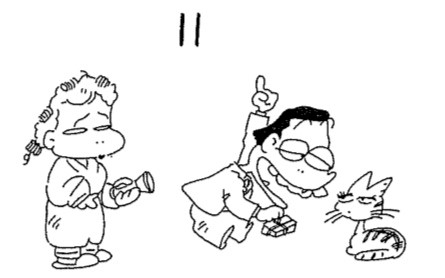
Now, please look at Figure 8 and imagine what would happen if I erased all the keiyu markers from that scene. As you can see from the resulting Figure 9, all the movement in the picture stops. More than half of the picture’s interesting content disappears. And, more importantly, what really disappears are the psychological aspects of the picture, as well as the feeling of time flowing sequentially. Manga has so many expressions that can exist because of these keiyu or codes that are independent [from other elements in the panel].
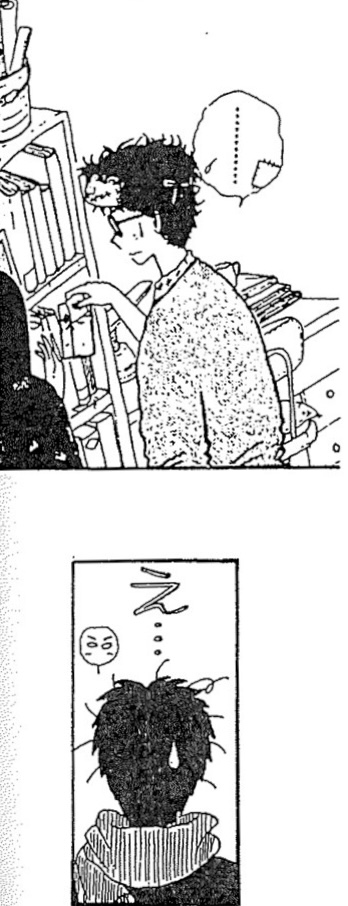
For example, it is easy to find examples in manga where “sweat” somehow appears in a word balloon or in a person’s hair (Figure 10). Since there is no way that sweat would manifest in such places, we have to assume these sweat beads are metaphors for the character’s psychological state, like a feeling of impatience or of confusion. Phenomenon like these suggest that “sweat” has come to have its own kind of coded function in manga, and we can understand that it acts the way a modifying clause works in a sentence. The sweat inside the speech balloon particularly is used equally with ellipses, which mean silence. (Those dots, by the way, are another standard trick used in manga that hint at thoughts or words that go unsaid.)
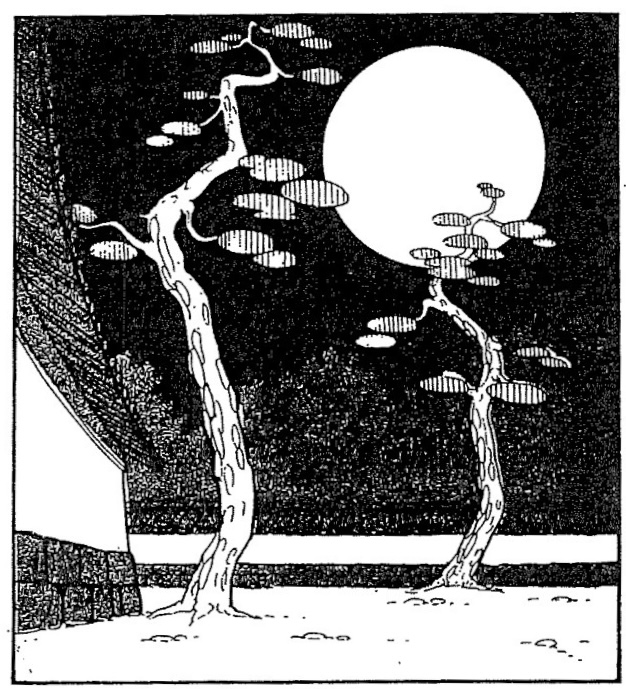
In manga, while we have coded expressions like the “shape metaphors” (keiyu) that work with their own independent expressions, there are also manga codes that do not function at the same level. For example, if you look at Figure 11, we can all agree that this is clearly a scene at night. Similarly, we have, by contrast, Figure 12, which is very clearly an afternoon scene. In Figure 11, it is night due to the way the artist blackens the sky with ink (beta). I suppose that the ground, the wall and the tree show up because of the brightness of the moon, but in reality our scene here should be one of utter darkness, where shadows run deep. Since the trees have the moon in the background, one might say that they should be in silhouette, but the artist has rendered them to stand out clearly.
When a character is rendered in this scene, he will be drawn so we can clearly make out his form, of course. He might be moving under the cover of night and perhaps out of sight, but the artist has to use this trick to allow the reader to fully see him. In kabuki theatre, there is a type of scene called a “danmari,” where characters move in the darkness by only groping around. Of course, even in kabuki “danmari” scenes, the stage is not actually dark. The audience can clearly see what is happening on the stage. Our manga example here by Yokoyama [Mitsuteru] represents a similar convention in manga. We can say that this is a very straightforward kind of coded expression found in manga.

In Figure 12, Yokoyama’s daytime scene has the same round celestial object like the moon in Figure 11, but its coded keiyu lines of light make it easily understood as the sun. These kinds of things probably slip past us readers without our being conscious of them, but all those lines, all the ink and all the pictures - they all work reciprocally to create meaning for us, even though we are unconscious of their functions.
Manga then can be understood as a kind of system where there are all types of pictures that have various visual functions. If that is true, then it is also possible to think about how manga is a system of codes that have certain designated functions which can also often transform, much like words do. This just might be my impression, but I think it is difficult to find other forms of comics that have all these various keiyu that create ways of expressions in the manner of Japanese manga.
The Similarities between Japanese Language and Manga Language
At this juncture it might be a bit rash on my part, but I would like to compare the structure of manga expression to the Japanese language. Because the types of expression in our language and the types of expression in our manga have utterly different means of communication, it would probably be better not to attempt an easy comparison like I am about to do, but I think I should give it a try because it can help me make my discussion of manga much easier to comprehend.
I had touched on this earlier,5 but the kind of expression that we today call manga basically consist of three main elements: pictures, panels, and words. As for the picture element, just like I was discussing previously, this is something we know is a system of agreed upon conventions that are semiotic in nature. The same is true for the element of words. You could say the same thing about the panel element, and I will talk more about this in an upcoming chapter,6 but all three elements function according to certain rules. Of course, all three are mutually connected to each other; plus, any one element (words, panels and pictures) will possess expressive aspects that share boundaries with the other two elements of the three.
For example, when it comes to word balloons, which have various shapes and forms, they have a role to modify the meaning of words but also to exist as a kind of picture. In other words, these balloons cross over into the territories of both words and pictures. What about onomatopoeia; for example, giongo [sound mimetics], gitaigo [mental-state mimetic expressions], etc.?7 They often give an auditory image that will mimic some sound, and they do so through the hand-drawn line that renders them. They can be drawn to show an explosion with explosive shaping; the sound of silence can be felt from a quiet-looking form (Figure 13). Although these expressions are clearly words, when drawn in this pictorial way their functions become all the more apparent. In other words, they are located somewhere between language and pictures.
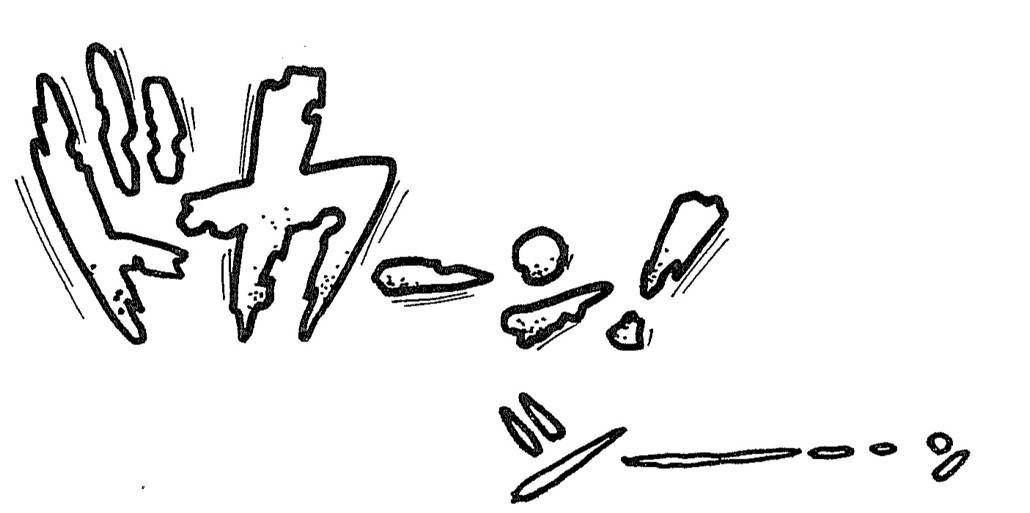
In addition, manga panels (koma) appear to the reader’s eye as frames, but they also abstractly segment the manga, acting with temporal and spatial functions. They work almost in the same way that sentence structure does for language. When you think about it, manga then has three main elements: pictures with their symbolic functions; words with their functions; and panels, which have larger syntactical functions.
Before going any further, let us take note of how Japanese is roughly half made up of kanji (C. hanzi), those Chinese characters that were imported to our language long ago. Originally, kanji often took the shape of the things they represented: hi, the character for sun or day, took the shape of the sun (taiyō); tsuki, for either the moon or month, took the shape of the moon. Kanji thus possess pictorial qualities (Figures 14a and 14b). And then, as the character for sun/day (hi) came in turn to mean “shining” (hikaru), there came be another kanji for “bright” (mei; akira), which is a combination of the sun (hi) and moon (tsuki) characters.

Following a regular method, from very complicated characters to more basic characters, which originally seemed very much like simple pictures, Chinese people combined and made their characters. I think we can almost say that this aspect of kanji is very similar to the kind of symbolic construction of manga.
A [written] Japanese sentence consists of both kanji and "readings" (yomi). These characters clearly reveal the way they are read and sounded out. Kanji words may preserve a kind of original Chinese reading (the on-yomi way), or those words might have a Japanese way to read them (kun-yomi). Regardless, as structure, visual elements and aural elements are segmented, and they together will form our written Japanese sentence as they are located to overlap with each other. From when we first imported kanji and started using letters to today, we have kanji and their readings in our heads, whether we are writing a sentence or if we use our mouths to express ourselves.
According to the anatomist Yōrō Takeshi, those very visual kanji characters are dealt with in a special part of the brain that focuses on the visual part of language; likewise, our kana scripts of hiragana and katakana, which are auditory, are dealt with in a separate part of the brain where mainly auditory aspects of language are processed. Then they seem to be merged again in another part of the brain (Figure 15). Because of that, when people have a disorder in one of these two areas of the brain, those people might have symptoms such as they cannot read specifically kanji, or they cannot read kana characters.

If it is possible for us to equate pictures with kanji, words with kana (particularly where lines of dialogue are only long lines of kana), and panels with sentence structure, then we can also say that manga expression itself begins to seem be structured a lot like the Japanese language. I might be making a very crude comparison here, but if we allow the assumption that Japanese manga are constructed in much more complex ways than those of Europe and America, then it might be possible to establish the idea that the Japanese language itself with its particular characteristics might play a role in that complexity of our manga expressions. This is something already suggested by Yōrō. And yet, if one goes too far in trying to assert that hypothesis, then we end up with nothing but an ethnocentric view of Japanese culture. “It is because Japanese are unique, some might say, that their manga is superior.” The idea then I just introduced can easily be connected to a short-sighted view like that. This hypothesis is interesting, but very hard to prove, and one would need to take very careful steps to do so.
In Tori Miki’s The Back Hip Circle of Love (Ai no sakaagari, 1985-1986), he has the following funny scene (Figure 16). A character (a double for the author) appears on stage with a guitar in hand. In his word balloon, there is the sound of him crooning out “Ha-a-a-a-a-a,” and so it is natural for us to think, “Oh, he must be singing a song.” And, it is also natural for us to also sense in our heads that those sounds are like the opening of some folky tune. There are symbols to indicate musical notes that help us to feel that way. However, as we turn the page, his “ha-a-a” gets connected to the rest of a Japanese word “-yai mono de,” and we then realize that this guy is first saying something [if in English] like “Time go-o-o-oh-“ and then “…o-o-es so fast…”
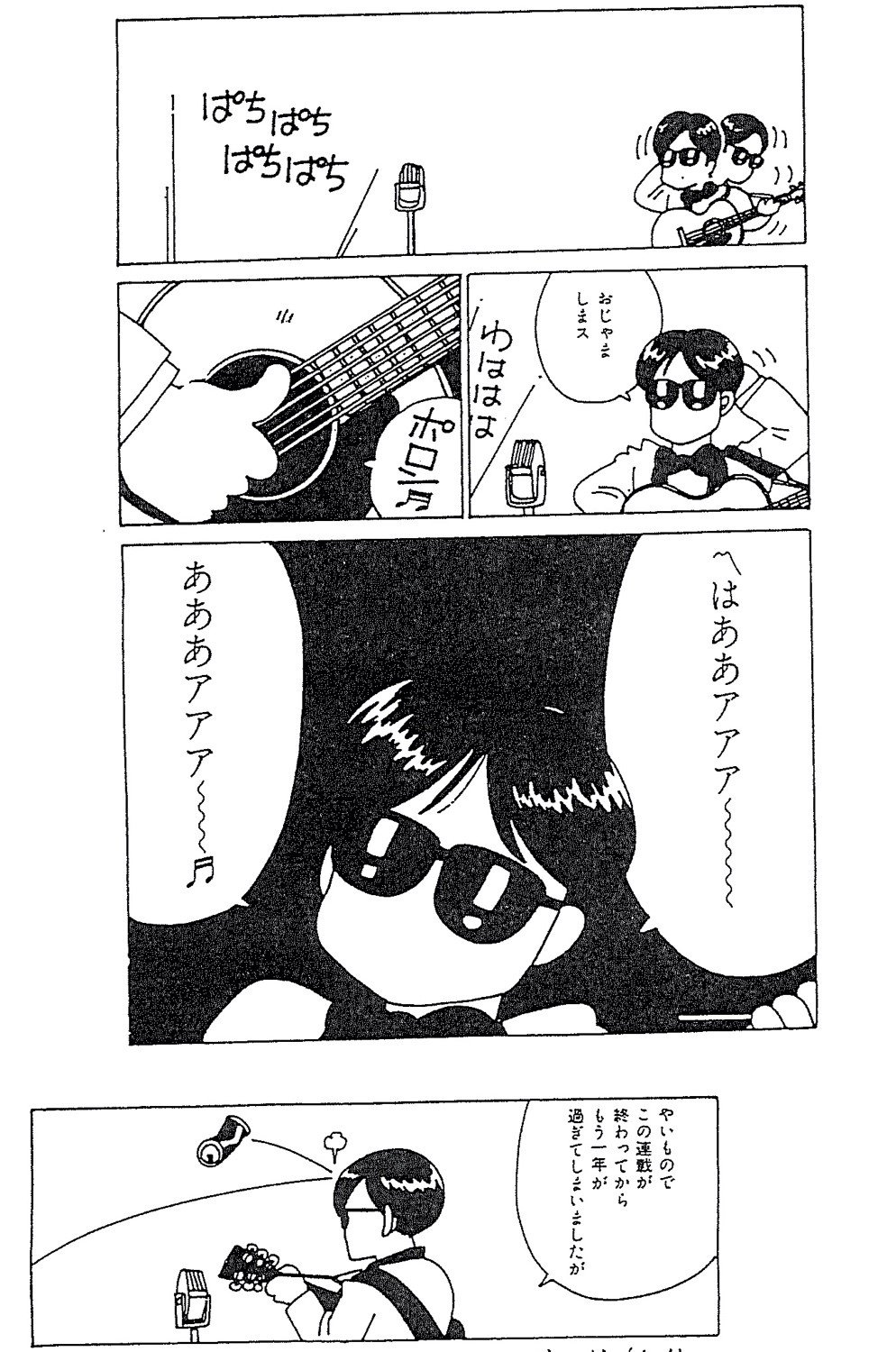
Here is what the scene would look like if we transcribe this kind of gag in a few sentences:
-Here I go standing at the microphone with my guitar in hand as I start to sing.
“Time go-o-o-oh…”
-After stretching out that vowel sound for ten beats, I suddenly break into a story.
“…o-o-oes so fast, once I end this long sequence, I—”
-Somebody from the audience then throws an empty can at me, hitting my head.
Should the reader imagine this scene from a vaudeville-like (yose) stage, there is no way this manga could be funny. My textual rendition is totally different from the manga, because in the manga’s picture, when you see the character getting up to do a rambling talk with his guitar, you know that this scene is very much related to its sounds.
The point of the humor here resides in the way the artist momentarily fills the gap between “hayai” [with kana] “hayai” [with kanji]: that is, the gap between the auditory characteristic of the kana characters and the kanji that has the same sound as the one indicated with these kana characters, by using the pictures and panels. I think we can say that this is a joke with a “beat” (ma). It is a joke that relies on turning the manga grammar upside down by skillfully applying pictures, words and panels.
* * *
The post The Structure of Expressions in Manga appeared first on The Comics Journal.

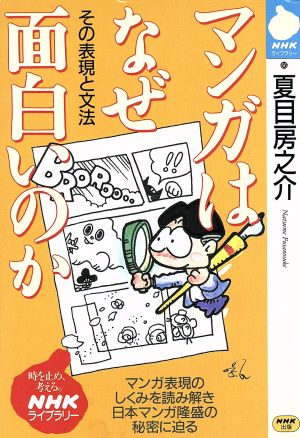
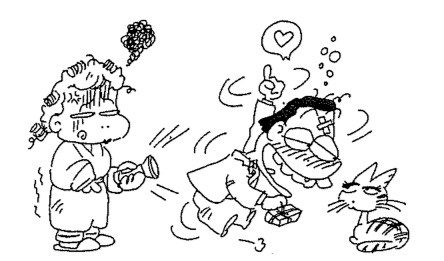


No comments:
Post a Comment